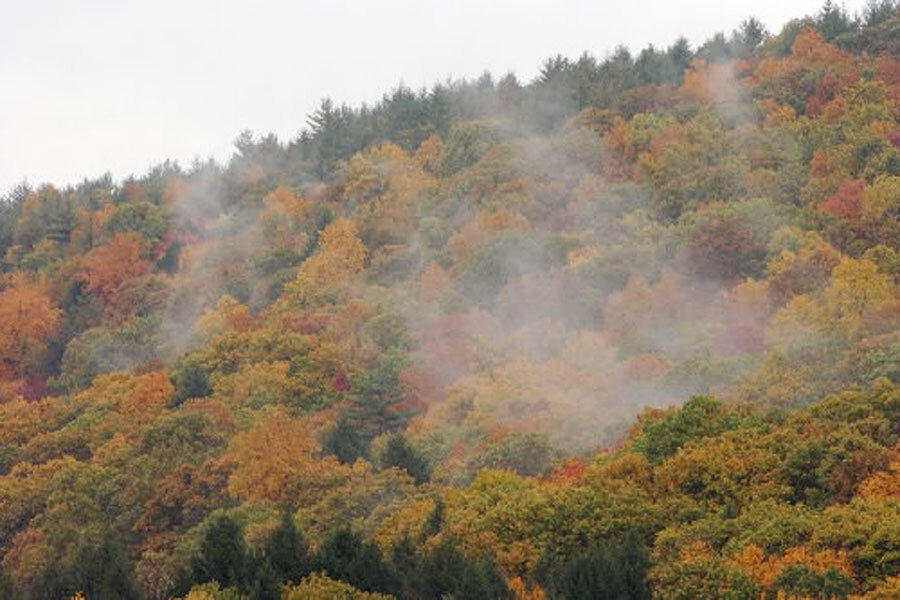How much are trees feeling the heat of climate change?
Loading...
Rising temperatures might not stress trees as much as previously thought. And that means they may continue to be efficient at scrubbing carbon from the atmosphere, even as the planet warms.
As a result, some equations in our climate models will likely have to be tweaked.
Forests are known for being massive carbon warehouses, drawing carbon dioxide out of the atmosphere through photosynthesis. Most of that carbon remains locked in trees' roots, trunks, branches, and leaves but a bit of it is emitted back into the atmosphere through a process called respiration.
Previous models had suggested that respiration in trees would increase exponentially as the planet heats up, thus feeding even more carbon dioxide into the atmosphere and increasing global warming further. But new research suggests that feedback loop won't be as dramatically affected by rising temperatures.
The researchers estimated that, without acclimation, exposure to temperatures 3.4 degrees Celsius (6.12 degrees Fahrenheit) above ambient temperatures would prompt the plants to emit 23 percent more carbon dioxide over a period of three to five years. But when using heat lamps on trees in a forest and measuring the emissions, they found that leaf respiration increased by just 5 percent, according to new research published Wednesday in the journal Nature.
"Plants are flexible and responsive and can adjust their physiology in the face of these changes," study co-author Rebecca Montgomery tells The Christian Science Monitor in an interview. "It's not perfect, but it's a ray of hope, a positive result that we really have been overestimating this respiration signal in the carbon cycle."
Previous estimates had been based on short-term studies and didn't give time for the plants to adjust to the rising temperatures. Much like a first-time runner would breathe heavier in a race than someone who had trained for marathons, this new long-term study shows how trees can acclimate to the new conditions over time.
Respiration is the process by which living cells metabolize sugars. Plants "eat" through photosynthesis, absorbing carbon dioxide in the process as they create sugars. Then, they metabolize those sugars in respiration by combining them with oxygen and that gives them energy to grow. But that process also releases carbon dioxide.
But the same amount of carbon that goes in does not come out. "Right now their net impact is one of a sink, which means they're taking in more carbon than they're giving off," Dr. Montgomery explains. "But the worry is that, as the climate warms, respiration may change faster than photosynthesis."
And that would mean forests would be less powerful in mitigating climate change.
The previous studies not only focused on the immediate impact of increased temperatures on plants but also were conducted in laboratory conditions. This new study was conducted out in the wilderness. The researchers shone heat lamps down on newly planted trees, buried heaters in the soil and measured how the plants reacted to the stress of warming in their natural environment.
Melanie Harsch, an ecologist at the University of Washington who was not part of this study, says the team's methods make for a more realistic study of "how plants will respond to climate warming."
And the new results "help us to build more realistic and more effective models" of how climate change will impact the environment, Dr. Harsch tells the Monitor.
"Changes are happening and they are going to happen," she says. "This helps us to plan and deal with the impacts of climate change in a more robust way. Our current models are only as good as the underlying data. And this improves the underlying data."
But, says Anne Kelly, an ecologist with the US Geological Survey who was also not part of the study, this may be only part of the picture. The study focused on boreal forests.
"I would be very cautious about applying their results to all kinds of forests everywhere," Dr. Kelly says. Other forests have very different climatic conditions and may see more or less precipitation, and these other factors could affect how readily the trees acclimate to global warming.
But "Boreal forests are one of the biggest biomes in the world and they store an incredible amount of carbon and they're projected to store a lot more carbon with warming. This study shows that they may be able to store that much more than we ever expected," she tells the Monitor.
"This, for once, is a bit of good news," Steven Running, a forest ecologist at the University of Montana who was not involved in this study tells the Monitor. "It shows that the system will continue to adapt as fast as it can and it will probably adapt in some additional ways like this that we're not expecting."
But, cautions Montgomery, this study doesn't mean we can let our carbon dioxide emissions run rampant because the trees will clean up the mess.
Although "we really have been overestimating this respiration signal in the carbon cycle," she says. "They're still emitting more" carbon dioxide than they would without the increasing temperatures.






